High Impact Tutoring Built By Math Experts
Personalized standards-aligned one-on-one math tutoring for schools and districts
In order to access this I need to be confident with:
Angles of a triangle Rearranging equations Pythagorean theoremSin Cos Tan
Here you will learn about sin cos tan (sine, cosine, tangent), including understanding what these three trigonometric functions are and their ratios, when to use these functions, their inverses, and how to use them.
Students will first learn about sin cos tan as part of geometry in high school.
What is sin cos tan?
Sin cos tan is a shortened description of the three trigonometric functions of sine, cosine, and tangent. These functions associate the ratio of two sides of a right-angled triangle with an angle.
To calculate using sin, cos and tan, you need to know their trigonometric ratios (remember that the ratio of two values is a division of these values).
Consider the right-angled triangle below.

- \theta is the angle
- The opposite side \textbf{(O)} to the angle
- The adjacent side \textbf{(A)} (next to) the angle
- The hypotenuse \textbf{(H)} the longest side (always the side facing the right-angle)
![[FREE] Trigonometry Check for Understanding Quiz (Grade 9 to 12)](https://thirdspacelearning.com/wp-content/uploads/2023/07/Trigonometry-check-for-understanding-quiz-listing-image-.png)
[FREE] Trigonometry Check for Understanding Quiz (Grade 9 to 12)
![[FREE] Trigonometry Check for Understanding Quiz (Grade 9 to 12)](https://thirdspacelearning.com/wp-content/uploads/2023/07/Trigonometry-check-for-understanding-quiz-listing-image-.png)
Use this quiz to check your grade 9 to 12 students’ understanding of Trigonometry. 15+ questions with answers covering a range of 9th to 12th grade trigonometry topics to identify areas of strength and support!
DOWNLOAD FREE![[FREE] Trigonometry Check for Understanding Quiz (Grade 9 to 12)](https://thirdspacelearning.com/wp-content/uploads/2023/07/Trigonometry-check-for-understanding-quiz-listing-image-.png)
[FREE] Trigonometry Check for Understanding Quiz (Grade 9 to 12)
![[FREE] Trigonometry Check for Understanding Quiz (Grade 9 to 12)](https://thirdspacelearning.com/wp-content/uploads/2023/07/Trigonometry-check-for-understanding-quiz-listing-image-.png)
Use this quiz to check your grade 9 to 12 students’ understanding of Trigonometry. 15+ questions with answers covering a range of 9th to 12th grade trigonometry topics to identify areas of strength and support!
DOWNLOAD FREEThe three trigonometric ratios can be used to determine a missing side or a missing angle. You use the following trigonometric formulae.

If you look at the letters only within the three triangles above, you get the abbreviation SOHCAHTOA where:
\quad - \quad \textbf{SOH} is the association of the sine of an angle (S) with the opposite side \hspace{0.85cm} (O) and the hypotenuse (H), of the triangle.
\quad - \quad \textbf{CAH} is the association of the cosine of an angle (C) with the adjacent side \hspace{0.85cm} (A) and the hypotenuse (H) of the triangle.
\quad - \quad \textbf{TOA} is the association of the tangent of an angle (T) with the opposite side \hspace{0.85cm} (O) and the adjacent side (A) of the triangle.
Step-by-step guide: SOHCAHTOA
You use one of the three trigonometric ratios of \textbf{sin} \, \bf{\theta}, \, \textbf{cos} \, \bf{\theta}, and \textbf{tan} \, \bf{\theta} to find one of the missing sides of a right angled triangle when you know another angle, apart from the right-angle.
You use the inverse functions of the three trigonometric ratios to determine a missing angle \theta (Greek letter theta).
- The inverse sine function is written as \theta=\sin^{-1}\left(\cfrac{O}{H}\right).
- The inverse cosine function is written as =\theta=\cos^{-1}\left(\cfrac{A}{H}\right).
- The inverse tangent function is written as \theta=\tan^{-1}\left(\cfrac{O}{A}\right).
Step-by-step guide: Trigonometric functions
What is sin cos tan?

Common Core State Standards
How does this relate to high school math?
- High School – Geometry – Similarity, Right Triangles, & Trigonometry (HS.G.SRT.C.6)
Understand that by similarity, side ratios in right triangles are properties of the angles in the triangle, leading to definitions of trigonometric ratios for acute angles.
- High School – Geometry – Similarity, Right Triangles, & Trigonometry (HS.G.SRT.C.8)
Use trigonometric ratios and the Pythagorean Theorem to solve right triangles in applied problems.
How to calculate using sin cos tan
In order to calculate using sin cos tan:
- Label the sides of the right-angled triangle that you have information about in relation to the angle \bf{\theta}.
- Choose the trig ratio you need.
- Substitute the values from the triangle into the function.
- Calculate the unknown side or angle, rearranging if necessary.
Sin cos tan examples
Example 1: missing side (sine)
Determine the length of the hypotenuse for the triangle ABC below.

- Label the sides of the right-angled triangle that you have information about in relation to the angle \bf{\theta}.
Labeling the sides in relation to the angle, you have,

2Choose the trig ratio you need.
You know that \theta=42^{\circ}, \, O=7 and H=x. Using SOHCAHTOA, you can use the sine ratio (SOH) to determine the missing length of the hypotenuse.

3Substitute the values from the triangle into the function.
Substituting these values into the trigonometry formula \sin \theta=\cfrac{O}{H}, you have \sin{42}=\cfrac{7}{x}.
4Calculate the unknown side or angle, rearranging if necessary.
You need x to be the subject of the formula and so you first have to multiply both sides by x to get,
x\times\sin{42}=7Dividing both sides of the equation by \sin{42}, you get
x=\cfrac{7}{\sin{42}}=10.46133585…The length of the hypotenuse x=10.46 \; cm\text{ (nearest hundredth)}.
Example 2: missing side (cosine)
Determine the length of the adjacent side for the triangle PQR below.

Label the sides of the right-angled triangle that you have information about in relation to the angle \bf{\theta}.
Labeling the sides in relation to the angle, you have,

Choose the trig ratio you need.
You know that \theta=51^{\circ}, \, A=x and H=12. Using SOHCAHTOA, you can use the cosine ratio (CAH) to determine the missing length of the hypotenuse.

Substitute the values from the triangle into the function.
Substituting these values into the trigonometry formula \cos\theta=\cfrac{A}{H}, you have \cos{51}=\cfrac{x}{12}.
Calculate the unknown side or angle, rearranging if necessary.
You need x to be the subject of the formula and so you need to multiply both sides by 12 to get,
12\times\cos{51}=x
x=12\cos{51}=7.551844693…
The length of the adjacent side x=7.55 \, cm\text{ (nearest hundredth)}.
Example 3: missing side (tangent)
Determine the length of the adjacent side for the triangle EFG below.

Label the sides of the right-angled triangle that you have information about in relation to the angle \bf{\theta}.
Labeling the sides in relation to the angle, you have,

Choose the trig ratio you need.
You know that \theta=12^{\circ}, \, O=7.5 and A=x. Using SOHCAHTOA, you can use the tangent ratio (TOA) to determine the missing length of the hypotenuse.
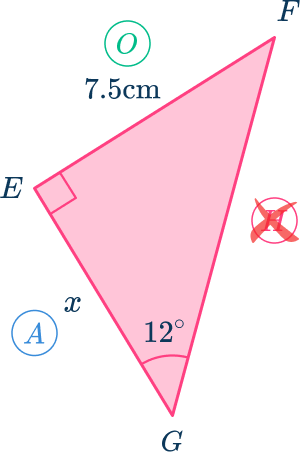
Substitute the values from the triangle into the function.
Substituting these values into the trigonometry formula \tan\theta=\cfrac{O}{A}, you have \tan{12}=\cfrac{7.5}{x}.
Calculate the unknown side or angle, rearranging if necessary.
You need x to be the subject of the formula and so you first have to multiply both sides by x to get x\times\tan{12}=7.5.
Dividing both sides of the equation by 12, you get
x=\cfrac{7.5}{\tan{12}}=35.28472582…
The length of the adjacent side x=35.28 \, cm\text{ (nearest hundredth)}.
Example 4: missing angle (sine)
Determine the size of the angle \theta for the triangle ABC below.

Label the sides of the right-angled triangle that you have information about in relation to the angle \bf{\theta}.
Labeling the sides in relation to the angle, you have,

Choose the trig ratio you need.
You know that O=5, \, H=13 and you want to find the angle \theta. Using SOHCAHTOA, you can use the sine ratio (SOH) however you need to use the inverse sine function as you need to calculate the angle.

Substitute the values from the triangle into the function.
Substituting these values into the trigonometry formula \sin\theta=\cfrac{O}{H}, you have \sin{\theta}=\cfrac{5}{13}.
This rearranges to \theta=\sin^{-1}\left(\cfrac{5}{13}\right)
Calculate the unknown side or angle, rearranging if necessary.
Using a calculator, you can simply input this to determine the angle.
\theta=22.61986495…
The angle \theta=22.6^{\circ}\text{ (nearest tenth)}.
Example 5: missing side (cosine)
Determine the size of the angle \theta for the triangle STU below.
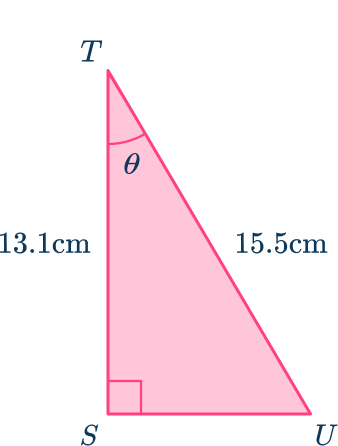
Label the sides of the right-angled triangle that you have information about in relation to the angle \bf{\theta}.
Labeling the sides in relation to the angle, you have,

Choose the trig ratio you need.
You know that A=13.1, \, H=15.5 and you want to find the angle \theta. Using SOHCAHTOA, you can use the cosine ratio (CAH) however you need to use the inverse cosine function as you need to calculate the angle.
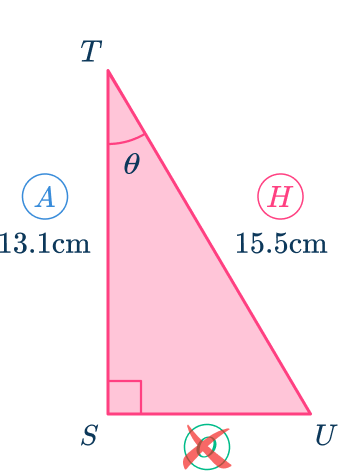
Substitute the values from the triangle into the function.
Substituting these values into the trigonometry formula \cos\theta=\cfrac{A}{H}, you have \cos{\theta}=\cfrac{13.1}{15.5}.
This rearranges to \theta=\cos^{-1}\left(\cfrac{13.1}{15.5}\right).
Calculate the unknown side or angle, rearranging if necessary.
Using a calculator, you can simply input this to determine the angle.
\theta=32.31077908…
The angle \theta=32.3^{\circ}\text{ (nearest tenth)}.
Example 6: missing side (tangent)
Determine the size of the angle \theta for the triangle XYZ below.

Label the sides of the right-angled triangle that you have information about in relation to the angle \bf{\theta}.
Labeling the sides in relation to the angle, you have,

Choose the trig ratio you need.
You know that O=1.96, \, A=2.34 and you want to find the angle \theta . Using SOHCAHTOA, you can use the tangent ratio (TOA) however you need to use the inverse tangent function as you need to calculate the angle.

Substitute the values from the triangle into the function.
Substituting these values into the trigonometry formula \tan\theta=\cfrac{O}{A}, you have \tan{\theta}=\cfrac{1.96}{2.34}.
This rearranges to \theta=\tan^{-1}\left(\cfrac{1.96}{2.34}\right).
Calculate the unknown side or angle, rearranging if necessary.
Using a calculator, you can simply input this to determine the angle.
\theta=39.94977158…
The angle \theta=39.9^{\circ}\text{ (nearest tenth)}.
Teaching tips for sin cos tan
- Introduce the unit circle to explain how these functions work for all angles, not just those in right triangles.
- Use real-world scenarios, such as calculating heights of objects using angles of elevation or depression, to illustrate the practical use of trigonometry.
- Introduce basic trigonometric identities, such as \sin^{2}\theta + \cos^{2}\theta=1, to deepen understanding and provide tools for simplifying expressions.
Easy mistakes to make
- Thinking a right-angled triangle is different from a right triangle
Right-angled triangles are sometimes called right triangles.
- Not knowing when to use SOHCAHTOA
You can use SOHCAHTOA to find a missing side of a right-angled triangle when you have another side and a given angle.
You can use SOHCAHTOA to find a missing angle of a right-angled triangle when you have two given side lengths.
If you have two sides and you want to find the third side of the triangle, you can use the Pythagorean theorem a^{2}+b^{2}=c^{2}.
- Not knowing when to use standard or inverse trig function
You use standard trig functions when you know the angle. You have to use the inverse trig functions when you don’t know the angle.
Related trigonometry lessons
- Trigonometry
- How to find the exact value of a trig function
- Law of sines
- Trig formula for area of a triangle
- Trig formulas
- Trig identities
- Law of cosines
- Trig table
Practice sin cos tan questions
1. Determine the length of the missing side of the right triangle below. Write your answer correct to the nearest hundredth ( 2 decimal places).





From the angle \theta=42^{\circ} you know that O=9 and H=x so you use the sine ratio, \sin\theta=\cfrac{O}{H}.
\sin{42}=\cfrac{9}{x}
x=\cfrac{9}{\sin{42}}=13.45028895…=13.45 \, cm\text{ (nearest hundredth)}
2. Determine the length of the missing side of the right triangle below. Write your answer correct to the nearest hundredth.
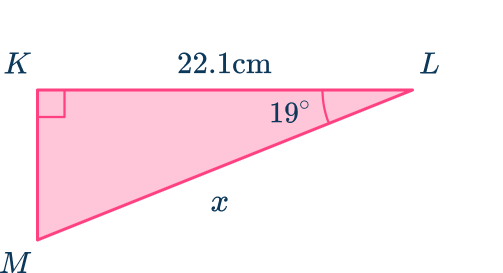




From the angle \theta=19^{\circ} you know that A=22.1 and H=x so you use the cosine ratio, \cos\theta=\cfrac{A}{H}.
\cos{19}=\cfrac{22.1}{x}
x=\cfrac{22.1}{\cos{19}}=23.37341705…=23.37 \, cm\text{ (nearest hundredth)}
3. Determine the length of the missing side of the right triangle below. Write your answer correct to the nearest tenth.





From the angle \theta=72^{\circ} you know that O=x and A=0.4 so you use the tangent ratio, \tan\theta=\cfrac{O}{A}.
\tan{72}=\cfrac{x}{0.4}
x=0.4\times\tan{72}=1.231073415…=1.2 \, cm\text{ (nearest tenth)}
4. Determine the length of the missing angle \theta in the right triangle below.





From the angle \theta you know that O=2.2 and H=4.4. As you need to find the angle, you use the inverse sine ratio, \theta=\sin^{-1}\left(\cfrac{O}{H}\right).
\theta=\sin^{-1}\left(\cfrac{2.2}{4.4}\right)=30^{\circ}
5. Determine the length of the missing angle \theta in the right triangle below. Write your answer to the nearest tenth.
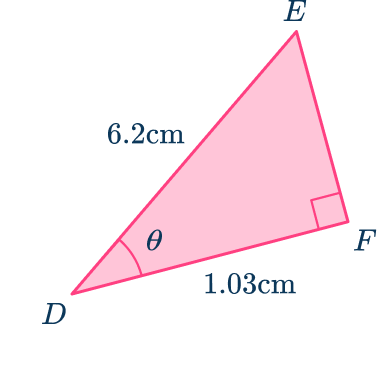




From the angle \theta you know that A=1.03 and H=6.2. As you need to find the angle, you use the inverse cosine ratio, \theta=\cos^{-1}\left(\cfrac{A}{H}\right).
\theta=\cos^{-1}\left(\cfrac{1.03}{6.2}\right)=80.4^{\circ} \text{ (nearest hundredth)}
6. Determine the length of the missing angle \theta in the right triangle below. Write your answer to the nearest hundredth.





From the angle \theta you know that O=6.5 and A=6.1. As you need to find the angle, you use the inverse tangent ratio, \theta=\tan^{-1}\left(\cfrac{O}{A}\right).
\theta=\tan^{-1}\left(\cfrac{6.5}{6.1}\right)=46.81830296…=46.82^{\circ}\text{ (nearest hundredth)}
Sin Cos Tan FAQs
A common mnemonic device for remembering the trigonometric functions sine, cosine, and tangent is: SOH CAH TOA.
Sine = Opposite/Hypotenuse
Cosine = Adjacent/Hypotenuse
Tangent = Opposite/Adjacent
Most calculators have dedicated sin, cos, and tan buttons. To find the value of these functions for a specific angle, input the angle and press the corresponding button. Make sure the calculator is set to the correct mode (degrees or radians) depending on the angle’s unit.
The unit circle is a circle with a radius of 1 centered at the origin of the coordinate plane. The coordinates of a point on the unit circle correspond to the cosine and sine of the angle formed by the radius and the positive x -axis. The tangent of an angle can be found by dividing the value of sin by the value of cos.
Cosecant (csc) is the reciprocal of sine: csc(\theta) = \frac{1}{\sin(\theta)}
Secant (sec) is the reciprocal of cosine: sec(\theta) = \frac{1}{\cos(\theta)}
Cotangent (cot) is the reciprocal of tangent: cot(\theta) = \frac{1}{\tan(\theta)}
The next lessons are
- Circle math
- Sectors arcs and segments
- Circle theorems
Still stuck?
At Third Space Learning, we specialize in helping teachers and school leaders to provide personalized math support for more of their students through high-quality, online one-on-one math tutoring delivered by subject experts.
Each week, our tutors support thousands of students who are at risk of not meeting their grade-level expectations, and help accelerate their progress and boost their confidence.

Find out how we can help your students achieve success with our math tutoring programs.
[FREE] Common Core Practice Tests (3rd to 8th Grade)
Prepare for math tests in your state with these 3rd Grade to 8th Grade practice assessments for Common Core and state equivalents.
Get your 6 multiple choice practice tests with detailed answers to support test prep, created by US math teachers for US math teachers!